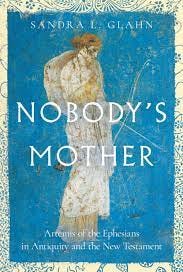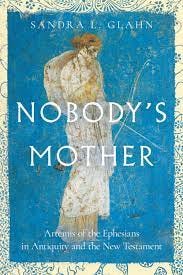Dr. Sandra Glahn has written a terrific book - Nobody’s Mother: Artemis of the Ephesians in Antiquity and the New Testament (available at Logos and IVP) - about the Artemis cult in first-century Ephesus and its significance for the study of the New Testament, especially Paul’s epistles, including the controversial passage 1 Timothy 2:11-15.
I’ve already reviewed the book and interviewed Dr. Glahn about her book.
My doktorvater, Rick Strelan, wrote his doctoral thesis about Paul, Artemis, and the Ephesians, so I’ve had an interest in the topic since I picked up Rick’s volume.
Glahn’s book is good because I think she debunks the idea that Artemis was a fertility goddess and she shows how the image of Artemis as the goddess of celibacy and childbirth is directly relevant to 1 Tim 2:15 where “women will be saved through child-bearing.” While there’s a few points I’d disagree with Dr. Glahn on, on the whole, I think she shows the relevance of Artemis to 1 Timothy.
However, my old friend, Denny Burk, president of CBMW, has written a critical review of Glahn’s book over at TGC and he is unpersuaded of its claim about the relevance of the Artemis cult for the interpretation 1 Tim 2:11-15.
On the one hand, I understand Burk’s concern that scholars can appeal backgrounds or postulate behind-the-scenes situations that either negate or radically alter the plain sense of the text.
For example, Paul says, “Do not forbid speaking in tongues” (1 Cor 14:39). But some commentators and preachers say, “Yeah, but the gift of tongues has ceased, Paul meant supernaturally speaking foreign languages, or Paul was indulging the Corinthians who were into ecstatic utterances, but he didn’t want other people doing it. So I’m gonna ban anyone in my congregation from speaking in tongues.” Whereas Paul says, “Yo Corinthobros, chill, don’t forbid tongues,” yet people can use context and setting as a workaround to prohibit what Paul expressly permits.
Also, if knowledge of ancient culture and archaeology is required for properly understanding the biblical text, then there is always the anxiety that only an elite pool of archaeologists and text critics will have the secret knowledge to interpret the New Testament. That would make biblical interpretation more elitist than accessible to others.
So I understand Burk’s concern here, which is legitimate. How does showing me a statue of Artemis negate the fact that Paul prohibits women from both teaching and holding authority over a man, a prohibition that is rooted in creation and not in the local situation? I get it!
But I see a few problems with Burk’s critique of Glahn.
First, Burk says that Paul doesn’t explicitly mention Artemis or the Artemis cult in the Pastoral Epistles. True, but 1 Corinthians 8-9 is about the collection for the Jerusalem church and Paul never once uses the word for “money.” In Paul’s letter to the Romans, he is writing in the aftermath of the expulsion and return of Jewish Christians to Rome, which Paul never mentions, but its effects on the contents of the letter are everywhere. In Romans 13, Paul does not mention Nero, but we know that Nero is in mind. Some things are just too obvious to need explicit statement, they are just part of the scenery or the assumed backstory.
Second, Burk cannot imagine some women in the Ephesian churches still participating in the Artemis cult. Well, I’ve written books on religious conversion in antiquity and I regularly talk to missiologists. What I’ve learned in this: when people get “converted” to Christianity, very often Christianity just becomes an add-on to their existing beliefs. They engage in a de facto syncretization of Christ-faith with Buddhism, Animism, or Artemis. It can take years to fully prune the old religious baggage before having a robust Christian faith. When I first became a Christian, I was still something of a religious pluralist, you know, many paths up the mountain, until my pastor took me to John 14:6 and explained that Jesus is the only Savior. I think it’s possible, if not probable, that some women, either on the fringes of the church, or for cultural and status reasons, tried to remain in contact with the Artemis cult in Ephesus as Glahn proposes.
Third, “saved through childbearing” is a tricky clause to understand, and there are all manner of options: Saved through Mary birthing Jesus, God’s promise is life not destruction for faithful women, Saved from deception, or (even) saved by submitting to the patriarchy. While “saved through childbearing” may or may not be a “slogan” of the Artemis cult, it definitely sums up the prayer of women to Artemis, “Goddess, give me a safe birth or a quick death.” I think Paul is saying that Christ not Artemis is the patron deity for Christian women in childbirth, who calls them to a life of faith and virtue. Unlike Burk, I find that very persuasive because it marries together literary contents and socio-religious context.
Check out the Ancients Podcast which did an episode on Artemis.
Finally, you could affirm everything that Glahn says about Artemis and its relevance for “saved through childbearing” in v. 15 and still believe that v. 12 should be taken literally as a prohibition of women teaching men and holding a position of authority in the church. So it’s not an either-or option here.
However, I’ve always said that “saved through childbearing” makes it more probable than not that Paul is primarily responding to a local issue about women, false teaching, and authority in the Ephesian churches. This explains why there is no analogous prohibition elsewhere in Paul’s letters and why in the Pauline assemblies we find women house church leaders (Nympha, maybe Chloe), women prophesying (Corinth), a woman apostle (Junia), a woman benefactor, deacon, delegate (Phoebe), and women among his “co-workers” (Priscilla, Mary, etc.).




